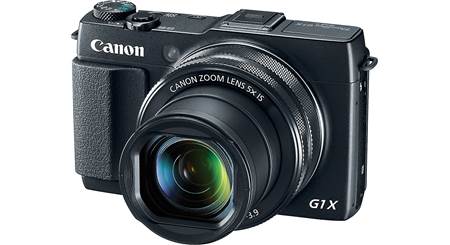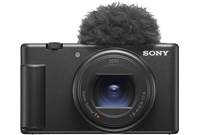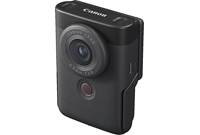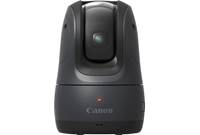About the Canon PowerShot G1 X Mark III

Canon's G-series flagship, reimagined

The G1 X Mark III has intuitively placed dials, a built-in flash, and all the processing power of Canon's interchangeable lens cameras.
Canon's G-series flagship, reimagined
The PowerShot G1 X Mark III is the latest flagship in Canon's G-series premium line of point-and-shoot cameras, and it's nearly a complete overhaul from the previous version. This powerful all-in-one camera uses the same 24-megapixel APS-C sensor, DIGIC 7 processor, and Dual Pixel autofocus system as Canon's latest interchangeable lens models.
Whether you're an enthusiast or a pro looking for a compact camera that does it all, this high-performance camera is equipped to deliver outstanding results in just about any situation.
Keep up with the action
The G1 X Mark III's Dual Pixel CMOS autofocus system is fast and smooth. This camera excels in challenging light and accurately tracks moving subjects. Capture sharply focused action sequences at up to seven frames per second. In Movie mode, focus stays natural and precise, even when switching between subjects.
Intuitive framing and focusing
The G1 X Mark III sports a high-resolution electronic viewfinder and a 3" rotating LCD touchscreen for easy, intuitive shooting from high or low angles. And it's great for framing self-portraits and group shots too. Use the touchscreen to change settings, define autofocus points, and trigger the shutter. Touch and Drag autofocus makes it easy to switch focus by dragging the AF frame on the LCD screen. And you can even do it while looking through the viewfinder.
Wireless connectivity adds versatility and convenience
The G1 X Mark III's Wi-Fi lets you upload and share photos and videos in a matter of moments. But the benefits of this camera's wireless connectivity don't stop there. You can exchange data with other Canon cameras, play back images and movies on a smart TV, and print directly to a Wi-Fi printer.
Canon's free Camera Connect app lets you manage photos and videos taken with the G1 X Mark III on your phone or tablet. And your device becomes an extension of the camera's touchscreen, letting you select focus points and trigger the shutter with just a quick touch.
Product highlights:
- 24.2-megapixel effective recording
- APS-C CMOS sensor for excellent image quality
- dust- and water-resistant construction
- 3" high-resolution (1.04-million-dot) rotating LCD touchscreen
- 2.36-million-dot Organic LED (OLED) super high-resolution electronic viewfinder for easy eye-level composition
- Touch and Drag autofocus links viewfinder and touchscreen for easy, intuitive focusing
- Smooth Zone autofocus lets you use your finger to track moving subjects
- f/2.8-5.6 lens with 3X optical zoom (35mm equivalent focal length: 24-72mm)
- built-in 3-stop neutral density filter
- optical image stabilization minimizes blurring caused by camera shake
- built-in Wi-Fi®, NFC touch pairing, and Bluetooth® for convenient sharing and control
- DIGIC 7 image processor for superior image quality and fast camera response
- Dual Pixel CMOS autofocus system for fast, accurate focusing
- panoramic shot mode for capturing expansive landscapes
Exposure Modes and Controls
- continuous shooting mode: up to 7 frames per second (up to 9 frames per second with AF Lock)
- shutter speed range: 1-1/2,000 seconds, bulb
- sensitivity or ISO (film speed equivalent) range: 100-3,200, expandable to 25,600 equivalent
- Manual, Program Shift, AE Lock, and AE Bracketing exposure modes
File Formats and Storage:
- still image storage modes: JPEG, RAW
- AVC/H 2.64 HD movies with stereo sound
- shoots HD video up to 1920 x 1080 resolution
- records photos and video onto optional SD, SDHC and SDXC memory cards
Included Accessories:
- rechargeable NB-13L lithium ion battery
- battery charger
- lens cap and lens cap string
- neck strap
Connections and Dimensions:
- high-speed USB 2.0 interface (cable not included)
- micro HDMI (Type D) output (cable not included)
- hot shoe for connecting an external flash
- 4-7/8"W x 3-1/8"H x 2"D
- weight: 14.1 oz. (with battery and memory card)
- warranty: 1 year
- MFR # 2208C001
What's in the box:
Canon PowerShot G1 X Mark III owner's manual
- Digital camera (black)
- 37mm Lens cap (installed)
- NB-13L Lithium-Ion rechargeable battery (3.6V 1250mAh 4.5Wh)
- CB-2LH Battery charger
- Neck strap
- 2 Strap adapters
- Lens Cap tether
- Getting Started booklet
- Warranty card
- Online registration card
- Important Safety Instructions (for battery charger)
Customer reviews for Canon PowerShot G1 X Mark III
Loading...
Loading reviews...
Average review:
5.0 out of 5 starsThanks for submitting your review
Customer photos
This review was collected as part of a promotion
Pros:
Cons:
More details on the Canon PowerShot G1 X Mark III

Features & specs
| General | ||
|---|---|---|
| LCD Screen Size | 3" | |
| Adjustable-angle LCD | Yes | |
| Wi-Fi | Built-in | |
| Touchscreen | Yes | |
| Waterproof | No | |
| GPS-enabled | Via Smartphone | |
| Lens 35mm Equivalent | 24-72mm | |
| Optical Zoom | 3x | |
| Digital Zoom | 4x | |
| Filter Diameter | N/A | |
| Manual Focusing | Yes | |
| Manual Exposure | Yes | |
| Built-in Flash | Yes | |
| HDMI Output | Micro | |
| Memory | ||
| Internal Memory | None | |
| Memory Stick | No | |
| CFexpress Cards | No | |
| CompactFlash Cards | No | |
| SD Cards | SD, SDHC, SDXC | |
| XQD Cards | No | |
| Image | ||
| Sensor Size | APS-C | |
| Megapixels | 24.2 | |
| Image Stabilization | Optical | |
| Highest Resolution | 6000 x 4000 | |
| 4K Video | No | |
| Video Resolution | 1920 x 1080 | |
| Dimensions | ||
| Width (inches) | 4-3/4 | |
| Height (inches) | 3-1/4 | |
| Depth (inches) | 2-7/16 | |
| Weight With Battery (ounces) | 14.1 | |
| Warranty | ||
| Parts Warranty | 1 Year | |
| Labor Warranty | 1 Year | |
Product Research
Features
Play, Edit, and Print Functions
Battery Information
Input and Output Notes
Software
Features
Vari-Angle LCD Monitor: The new flagship of the Canon PowerShot line, the G1 X Mark III, has a 3" TFT color vari-angle LCD monitor with electrostatic capacitive touchscreen. The LCD screen has a resolution of approximately 1.04 million dots. The monitor has an approximately 100% picture coverage. The touch-sensitive panel gives you easy access to operations, menus, and controls. Using Touch AF, you can set the focus point and activate the shutter release with the touch of a fingertip. Like modern smart devices, you can also utilize the swipe and pinch actions on the LCD panel for other functions. The vari-angle LCD monitor can swing out 180° and rotated 90° forward or 45° backward, allowing you to take pictures from nearly every angle.
Electronic OLED Viewfinder: In addition to the LCD monitor, the camera has a 0.39" Electronic Viewfinder with OLED technology. It features approximately 2.36 million dots to give you great details as you frame your images. You can manually adjust the brightness of the LCD monitor and viewfinder separately as needed.
Touch & Drag AutoFocus: While looking through the viewfinder, you can touch the LCD touch screen and drag the AF frame to the spot where you want the camera to focus. You can choose to have the Touch & Drag operations Absolute (moving to the touched or dragged position on the screen) or Relative (moving in the general direction you drag, no matter where you touch the screen. The area of the screen where Touch & Drag operations can be restricted, if needed.
Image Sensor: For optimal image quality, the camera uses a large 24.2 Megapixel CMOS image sensor. This APS-C sized image sensor is the same size as those found in many interchangeable lens cameras, including the Canon EOS 77D and 80D. It has a native 3:2 aspect ratio, with a maximum resolution of 6000 x 4000 pixels.
Image Processor: The G1 X Mark III features Canon's latest generation DIGIC 7 Image Processor. The new processor offers improved light sensitivity for higher resolution with less noise when shooting in dark conditions. The camera has a wide ISO range of 100-25600 for still images and videos. It also allows high speed continuous still image recording at full resolution.
Built-in Wi-Fi/Bluetooth: The camera is equipped with both Wi-Fi and Bluetooth that let you connect with a variety of other devices. Connecting the camera to your PC, smartphone or tablet via Wi-Fi lets you send images to these device for uploading images to social networking sites, photo and video-sharing websites, or use in emails, using the Canon iMage Gateway application. You can also send images to other cameras or wireless printers. With the Canon Camera Connect app (for iOS and Android), you can use Near-Field Communications (NFC) to easily pair the camera with your NFC-compatible Android phone by touching the two devices together at the camera's "N-mark" on the bottom of the camera. You can also pair the camera with a smartphone via Bluetooth (Low Energy) for remote shooting and viewing images on the camera using the Camera Connect app. Using the GPS location information (latitude, longitude, altitude) on the smartphone, you can geotag your images and display your photos on a map.
Recording Media: The camera records still images or moving images with stereo audio on SD, SDHC, and SDXC Memory Cards, including support for high-speed UHS-I memory cards. A 16 GB SDHC card can hold 1833 images (6000 x 4000, Fine compression) or approximately 59 min 30 sec of Full HD video (1920 x 1080/59.94 fps).
File Formats: The G1 X Mark III records still images and movies in the following file formats:
- JPEG: JPEG images are processed inside the camera for optimum image quality and compressed. There are two compression ratios to choose from: Fine and Normal. You can record JPEG images in Large, Medium, Small 1, and Small 2 in 16:9, 3:2, 4:3, and 1:1 aspect ratios.
- RAW: The RAW file format records the image data as captured by the camera imaging element without further processing. The images show almost no deterioration in image quality, and are a higher quality than JPEG images. The image data must first be processed in the camera, or on your computer using Digital Photo Professional software (available from the Canon website via free download). You can adjust the images without deterioration, and then convert the image to a JPEG or TIFF file. You can choose to record RAW files or JPEG files separately or simultaneously. RAW images can be recorded in any aspect ratio at the same resolution as a Large image.
- Movies: Using the dedicated Movie button, you can record movies in High Definition or Standard Definition with stereo sound in MP4 format: Image Data: MPEG-4 AVC/H.264; Audio Data: MPEG-4 AAC-LC. HD Movies are recorded at 1920 x 1080 at 60, 30, or 24 fps and 1280 x 720 at 30 fps. SD Movies are recorded at 640 x 480 at 30 fps. In addition, the camera can record Time-Lapse movies to compress long events into a short period of time, and Star Time-Lapse movies to show movement of objects in the night sky.
Image Sizes: The camera can record in the following image sizes and aspect ratios for JPEG and RAW still images:
| Image Size | 16:9 | 3:2 | 4:3 | 1:1 |
|---|---|---|---|---|
| Large / RAW | 6000 x 3368 | 6000 x 4000 | 5328 x 4000 | 4000 x 4000 |
| Medium | 3984 x 2240 | 3984 x 2656 | 3552 x 2664 | 2656 x 2656 |
| Small 1 | 2976 x 1680 | 2976 x 1984 | 2656 x 1992 | 1984 x 1984 |
| Small 2 | 2400 x 1344 | 2400 x 1600 | 2112 x 1600 | 1600 x 1600 |
Wide-Angle 3x Optical Zoom Lens: The PowerShot G1 X Mark III is equipped with an f/2.8-f/5.6, 3x Optical Zoom lens with a focal length of 15-45mm (35mm film equivalent: 24-72mm. The 4x digital zoom extends the camera's telephoto capabilities to a total zoom of 12x. The focusing range is 3.9" to infinity (Wide) and 11.8" to infinity (Tele). In Macro and Underwater Macro, the focusing range is 3.9" to 1.6' only.
Digital Tele-Converter: Using the built-in Digital Tele-Converter, you can increase the focal length of the lens by approximately 1.6x or 2.0x. The equivalent focal length when using the 1.6x digital tele-converter is 38.4-115.2mm. When using the 2.0x tele-converter, the focal length is 48-144mm. The Digital Tele-Converter cannot be used together with the digital zoom.
Preset Focal Lengths: You can shoot at preset focal lengths of 24mm, 28mm, 35mm, 50mm, and 72mm. This Step Zoom feature allows you to quickly zoom in or out to equivalent focal lengths of common prime lenses by turning the lens ring.
Optical Image Stabilization: Optical (lens shift type) Image Stabilization allows you to minimize the camera shake which results in blurred images when you shoot distant subjects that have been magnified or when you shoot in dark conditions. Intelligent Image Stabilization (Intelligent IS) automatically selects one of six modes of image stabilization depending upon the shooting conditions:
- Normal: Image stabilization for still images
- Panning: Image stabilization for still images, when you follow subjects horizontally or vertically with the camera
- Hybrid IS: Image stabilization for macro shots and macro movie recording
- Dynamic IS: Image stabilization for movies, reducing strong camera shake as when shooting while walking.
- Powered IS: Image stabilization for subtle camera shake, such as when shooting movies at telephoto.
- Tripod IS: No image stabilization, because the camera is mounted on a tripod, or held still by other means. However, during movie recording, this mode will counteract wind or other sources of vibration.
Star Shooting Modes: The G1 X Mark III features several Star Shooting modes to help you take photographs of stars in the night sky. Each of these modes requires a tripod to prevent camera shake. Other functions, including Night Display, Color Adjustment, and Star Emphasis, help you make your nighttime photos better. The Star Shooting modes include:
- Star Nightscape: Lets you capture impressive shots of starry skies above night scenes. The stars are automatically enhanced to make them more visible.
- Star Trails: Streaks created by the movement of stars through the sky. You can set a shutter speed and the number of shots, and the camera shoots continuously, over an extended period (around two hours).
- Star Time-Lapse Movie: Still images are captured continuously at a specified interval and over a certain, and combined to create a movie. During playback, you can view the movement of stars through the sky in a short time.
AF-Assist Beam: The AF-assist beam will sometimes emit when the shutter button is pressed halfway to assist focusing in certain conditions, i.e. dark conditions. The AF-assist beam can be turned off. If animals are your subject, turn off the beam when shooting in the dark to avoid startling them.
Focus Lock: If it becomes difficult to focus on the subject due to low contrast to the surroundings, close up and far away subjects in the same shot, or quickly moving subjects, you can choose to lock the focus or auto focus on an object at a similar distance, then shoot the picture after recomposing the shot.
Focus Bracketing: The camera automatically takes three shots; one at the manual focus position, and one each with focus positions preset farther and nearer. The three shots are taken at the same interval as continuous shooting. The farther and nearer focus positions can be set in three steps.
Continuous Shooting Mode: With the DIGIC 7 Image Processor, the camera can capture multiple shots of a fast-moving subject while you hold the shutter button down. You can record up to 7 frames per second in Servo H (high speed) mode, and up to 9 fps in One Shot H mode. In low speed continuous shooting mode, you can capture approximately 4 fps in either mode.
Panoramic Shooting: The camera can record panoramic images, either vertically or horizontally. Once you have switched to the Panoramic Shot Mode, you can begin shooting by pressing and holding the shutter button as you pan the camera. The captured images are combined in the camera to produce dramatic panoramic photos.
Self-Timer: There are three self-timer modes to choose from:
- 10 Second: The camera will activate approximately 10 seconds after a preset time after shutter button is pressed to allow the photographer time to get into the shot.
- 2 Second: The 2-second self timer lets you shoot extreme closeups or distant subjects with high zoom rates without camera shake.
- Custom: The camera features a custom self timer, allowing you to set the time delay (0-10, 15, 20, or 30 seconds) and the number of shots taken (1-10 shots).
Shooting Modes: Using the Mode Dial on the top of the camera, you can select from numerous shooting modes:
- Smart Auto: Advanced Canon technology intelligently analyzes your situation and shooting conditions, and automatically selects an appropriate setting.
- Hybrid Auto: You can make a short movie of the day while shooting still images. The camera records 2-4 second clips of scenes just before each shot and combines them into a digest movie.
- Program AE (P): The camera automatically sets both the aperture and the shutter speed.
- Shutter Speed Priority (Tv): When you set the shutter speed, the camera sets the aperture according to shooting conditions. The shutter speed can be set between 1/2000 and 30 seconds.
- Aperture Priority (Av): When you set the aperture, the camera sets the shutter speed according to shooting conditions. The aperture can be set between f/2.8 and f/16 (wide angle) and f/5.6 and f/16 (telephoto), depending upon the zoom position.
- Manual (M): The aperture (f/2.8-16 (W) or f/5.6-16 (T)) and the shutter speed (1/2000 to 30 seconds) are manually set.
- Custom Modes (C1/C2): You can register commonly used shooting modes and settings to your preference. These can be stored under C1 or C2 on the Mode Dial.
- Movies: allows you to set the camera for movies, and configure the settings. The camera has a dedicated movie button to start and stop movie recording.
- Scene Modes: Appropriate settings for specific scenes and shooting conditions: Portrait, Handheld NightScene, Underwater (requires optional waterproof case), and Fireworks.
Self Portrait: To take high quality pictures of yourself, you can use the Self-Portrait mode with its many options. With the LCD panel facing toward the front, you can frame yourself without guessing. The Self-Portrait mode offers five levels of background defocusing, five levels of brightness, and five levels of skin smoothing. The touch shutter is activated during this mode, so you can take the image by simply touching the screen with your finger.
Special Effects: A variety of special effects are available for applying to your images when shooting: Smooth Skin, Monochrome, Soft Focus, Fish-eye Effect, Toy Camera Effect, Miniature Effect, Like Oil Paintings, and Like Watercolor Paintings.
Exposure Compensation: When shooting against a bright or dark background, you may need to correct the exposure so that the subject is correctly lit. You can adjust the exposure from -3 to +3 in 1/3-stop increments.
High Dynamic Range (HDR): When shooting in the HDR mode, three consecutive images are taken, each at different brightness levels. The camera combines image areas with optimal brightness to create a single image. This reduces washed out highlights, and brings out details in shadowed areas that tend to get lost in high-contrast shots.
Locking the Exposure Setting (AE Lock): You can set the exposure and focus separately. This is effective when the contrast is too strong between the subject and background, or when a subject is backlit.
Auto Exposure Bracketing (AEB): In this mode, the camera automatically changes the exposure within a set range to take three shots at the same interval as continuous shooting. The images are shot in the following order: standard exposure, underexposure, and overexposure. You can set the amount of under- or over-exposure from -2 to +2 in 1/3-stop increments.
Metering Modes: You can select from the following metering modes:
- Evaluative: Used for standard conditions. The area within the frame is divided into several zones and light is measured based on subject position, brightness, direct light and backlighting.
- Spot: Meters the area within the spot AE point at the center of the LCD monitor.
- Center-Weighted Averaging: Averages the exposure from the entire image, but places more weight on the subject at the center.
ISO Settings: The PowerShot G1 X Mark III features Auto and Manual ISO. The higher the ISO, the greater it reduces the effects of camera shake and sharpens subjects in low-light situations. In Auto Mode, the ISO speed is adjusted from 100-3200. In P Mode, you can set the ISO manually from 100 to 25600 in 1/3-stop increments. You can also set the maximum Auto ISO speed from 400 to 25600.
Built-In Flash: The PowerShot G1 X Mark III has a built-in pop-up flash. You can select Auto (flash fires in low light), On (flash always fires), Slow-Synchro (flash timing is adjusted to slow shutter speeds) or Off (flash doesn't fire). The built-in flash has a range of 1.6' to 29.5' in Wide Angle and 4.6' to 14.8' in Telephoto. You can adjust the flash output in 3 levels (in Tv, Av, and M modes) and flash exposure compensation (+/-2 stops in 1/3 stop increments). In the menu, you can add the following flash functions when the flash is set to On or Auto:
- Red-Eye Correction: You can automatically correct red-eye that occurs in images taken with the flash.
- Red-Eye Reduction Lamp: The red-eye reduction lamp lights in order to reduce the red-eye effect that occurs when shooting in dark conditions with the flash.
External Flash: The camera has a hot shoe for adding one of the following optional Canon Speedlites: 600EX II-RT, 600EX-RT, 580EX II, 580EX, 430EX III-RT, 430EX III, 430EX II, 430EX, 320EX, 270EX, 270EX II, and 220EX.
ND Filter: The ND filter reduces light intensity to 1/8 (3-stops) of the actual level, allowing for slower shutter speeds and smaller aperture values. Use of a tripod is recommended with the slower shutter speeds to prevent camera shake.
White Balance: You can choose from the following white balance settings:
- Auto: The camera sets the white balance automatically according to shooting conditions.
- Daylight: For recording outdoors on a bright day.
- Shade: For shooting in the shade.
- Cloudy: For recording under overcast, shady or twilight skies.
- Tungsten: For recording under tungsten and ordinary incandescent lighting.
- White Fluorescent: For recording under white fluorescent lighting.
- Flash: For when recording with the flash.
- Underwater: Underwater sets the optimum white balance for taking pictures underwater; reducing blue tones to produce natural, vibrant hues.
- Custom: Allows you to manually set the white balance and store the settings.
Display Overlays: You can display a variety of guides and overlays in the viewfinder or LCD to aid you in shooting images. These include shooting information, grid lines, an electronic level, and a histogram.
Wind Filter: The Wind Filter suppresses noise during audio recording when the wind is strong.
Play, Edit, and Print Functions
Review: After an image is recorded, it will appear in the LCD monitor for a preset number of seconds for reviewing. You can select the review time from 2 seconds, 4 seconds, 8 seconds, or Off. It will also display until you press the shutter button halfway to focus your next shot (Hold).
Focus Check Display: Focus Check display allows you to check the focus of image taken and allows you to easily check facial expressions and whether a subject's eyes are closed. This feature can be set to allow you to check the focus of an image taken right after shooting the subject.
Jump Images: When you have a lot of images recorded onto a memory card, you can use the Jump feature to speed up your search for the image you want to view. You can choose from the following categories:
- Favorites: displays images tagged as favorites
- Shot Date: displays the images shot on a specified date
- Still/Movie: jumps to only still images or only movies
- Jump 10 Images: jumps over 10 images at a time
- Jump 100 Images: jumps over 100 images at a time
Index Replay: This feature allows you to view 6, 12, 42, or 110 images at once on the LCD monitor so that you can search for an image quickly.
Image Magnification: When viewing a still picture in Single Image Replay mode, you can magnify the image up to 10x to get a closer look at the detail. You can also maneuver around in the magnified picture by using the multi-purpose control dial.
Rotating Images: You can rotate an image by 90° or 270° clockwise in the LCD monitor.
Slide Show: Images stored on a memory card can automatically be displayed one-by-one using the Slide Show function. Each image displays for approximately 3-10, 15, 30 seconds. You can choose whether you want a fade transition effect or not.
Movie Playback: In addition to normal playback of your video clips the camera features slow-motion, fast-forward, rewind and frame-by-frame playback.
Trimming: You can trim a portion of a recorded image and save it as a new image file. You can also trim the beginnings and ends of recorded movies in one-second increments.
Resizing Images: You can resize images to a lower pixel setting and save the resized image as a separate file.
Protecting Images: The protect feature allows you to protect important images from accidental erasure.
PictBridge/Wireless Printing: You can connect this camera directly to a PictBridge-compatible printer of any brand with an optional USB cable and print photos without having to connect it to a computer. You can also connect the camera wirelessly via an access point or directly.
Battery Information
Power Requirements: The Canon PowerShot G1 X Mark III powered by the supplied NB-13L rechargeable Lithium-Ion battery pack (3.6V / 1250mAh / 4.5Wh). The battery pack can be charged in the supplied CB-2LH battery charger in approximately 2 hours and 10 minutes. The typical performance of the battery is as follows:
| Number of Still Images (Normal Mode) | Monitor on | Approx. 200 shots |
|---|---|---|
| Viewfinder on | Approx. 200 shots | |
| Number of Still Images (Eco Mode) | Monitor on | Approx. 250 shots |
| Movie Recording (Typical) | Monitor on | Approx. 45 minutes |
| Viewfinder on | Approx. 45 minutes | |
| Movie Recording (Continuous) | Monitor On | Approx. 80 minutes |
| Viewfinder On | Approx. 80 minutes | |
| Playback Time | Approx. 4 hours | |
Eco Mode: To save battery power, the screen darkens when the camera is not used for approximately two seconds, then turns off after another ten seconds. The camera shuts itself off after three minutes of inactivity.
Input and Output Notes
Digital Terminal: The PowerShot G1 X Mark III has a Micro USB Hi-Speed compliant terminal to allow you to connect the camera to a compatible computer or compatible printer via a USB cable (not included).
Micro HDMI Output: The PowerShot G1 X Mark III features a micro-HDMI (Type D) output for connecting the camera to your HDTV. No HDMI cable is included with the camera.
Software
Software: The PowerShot G1 X Mark III does not come with software in the box. The following software programs are available for download from the Canon website:
- CameraWindow: import images and change camera settings; add Picture Styles saved on your computer to the camera
- Map Utility: use a map to view GPS information added to images
- Digital Photo Professional: browse, process, and edit RAW images
- Picture Style Editor: edit Picture Styles and create and save Picture Style files
- Camera User Guide
Operating Systems: The software is compatible with the following operating systems:
- Windows: Compatible with Windows 10, Windows 8.1, Windows 8, and Windows 7 (SP1)
- Macintosh: Compatible with macOS High Sierra v10.13 (CameraWindow only), macOS Sierra v10.12, OS X El Capitan v10.11, and OS X Yosemite v10.10
The Canon PowerShot G1 X Mark III replaces these items

Canon PowerShot G1X Mark II
- 3" high-resolution flip-out LCD touchscreen (1.04 million-dot resolution)
- large 1.5" high-sensitivity CMOS image sensor for top-notch image quality
- built-in Wi-Fi® connectivity for easy sharing of photos and video, plus Near Field Communication (NFC) touch pairing with compatible Android™ devices
Loading...
Loading accessories...
Customer Q&A
1 question already asked
Loading...
Loading articles...














